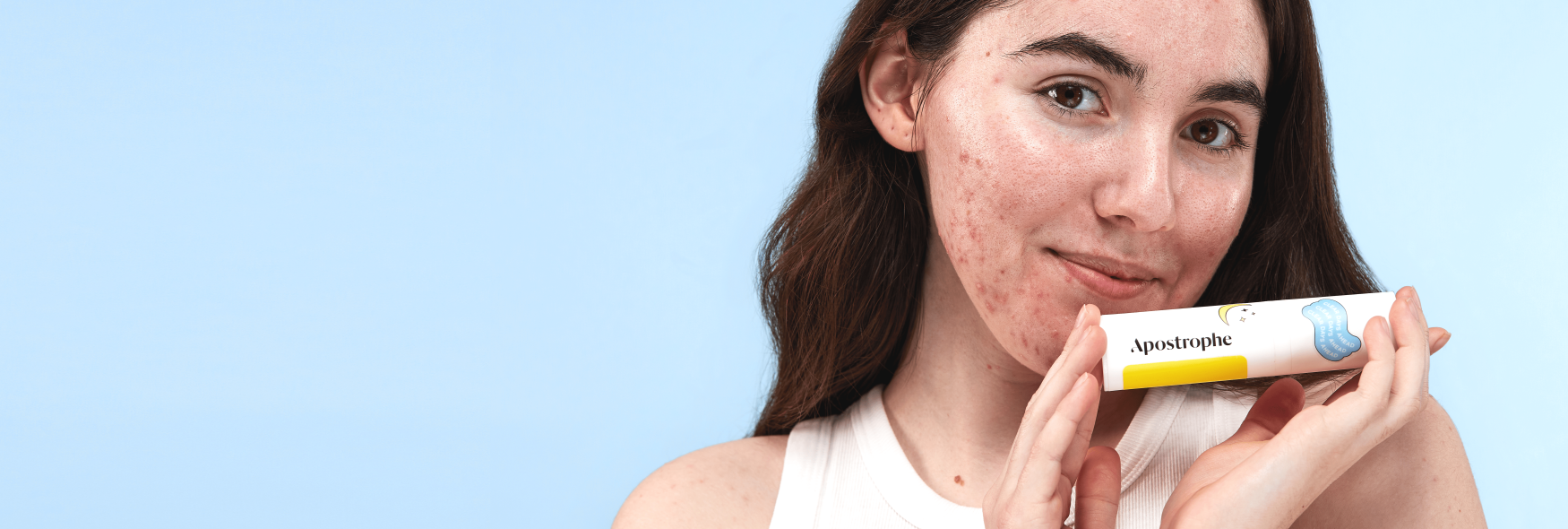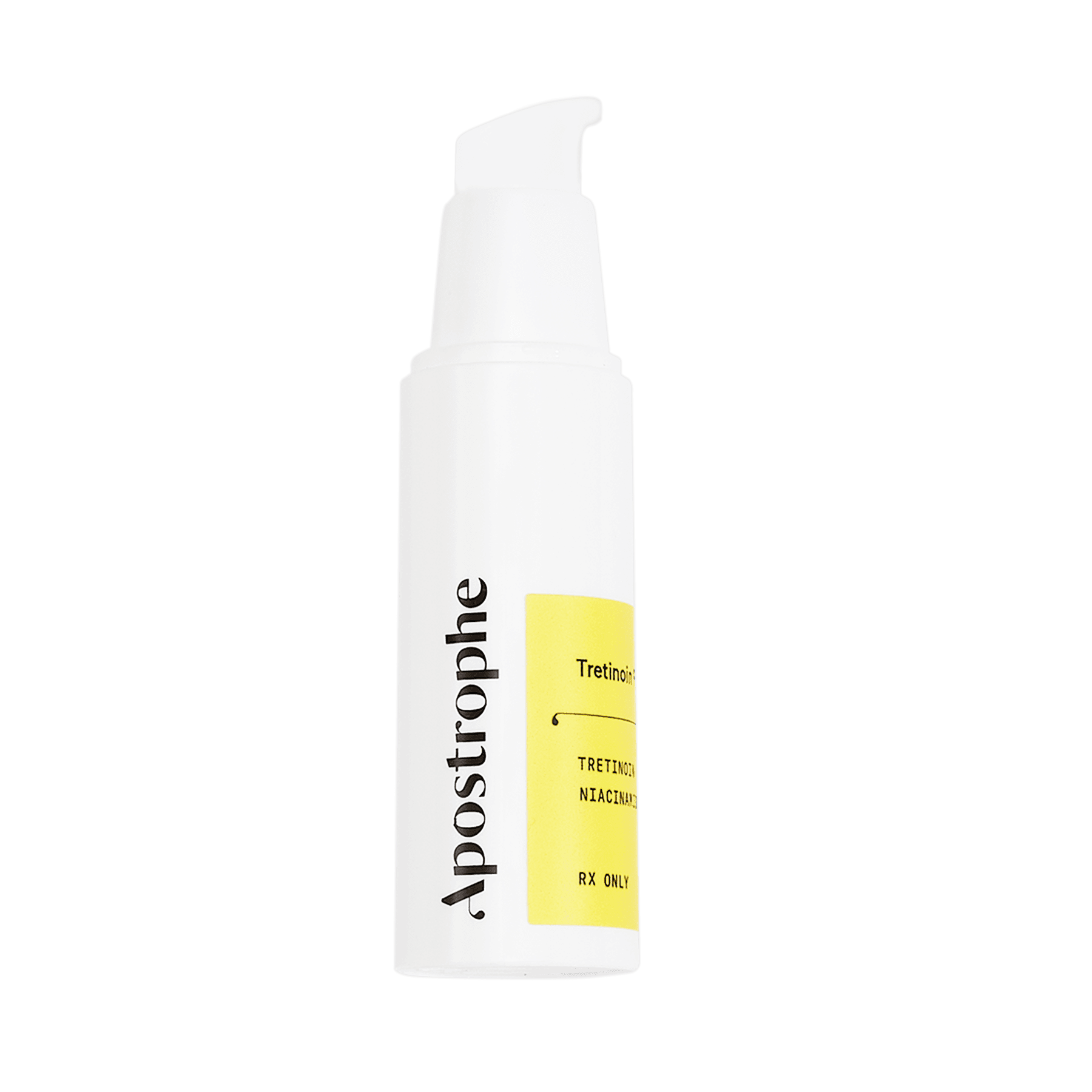Education
Inflammatory acne: causes and treatment options


SHARE
Education
Inflammatory acne: causes and treatment options
Medically reviewed by Kristin Hall, FNP
Written by Apostrophe Team
Last updated 11/1/2024
Acne is never a good thing to have, but if you know someone who’s been suffering from it for a long time, they’ll probably tell you that there are better kinds to have than others.
Some are less severe, while others can be an absolute pain in the ass and even leave scarring.
A single pimple from time to time may sap your self-confidence, but more severe inflammatory acne can rob you or anyone else of their good looks in a big way. It can also be much harder to treat.
Luckily, we’ve got the goods on the best ways to treat inflammatory acne and how it works. Let’s start with a brief refresh on acne, though.
What Is Acne?
Acne is what happens when things get clogged up in your pores, and in some cases, infected.
There are essentially four main contributing factors to acne: dead skin cells, your natural oil production, your skin’s hydration, and the bacteria (or fungi) in your pores.
Here’s how it works: pimples of all kinds occur when the dead skin cells from within the pore fail to safely exit the vehicle after they’re dismissed.
If they’re particularly dry, then they can pile up, which will clog the pore with sebum (oil) as your body produces more to lubricate those stuck, dry cells.
Oil and dead skin cells present the growth medium and food source for bacteria (respectively), which can make it a perfect breeding ground for many of them.
Bacterial infections can be bad, but even if you don’t get bacteria reproducing, you can still get inflammation and, well, pimples.
Inflammatory Acne vs Noninflammatory Acne
For the purpose of this conversation, we can arrange the types of acne into two distinct groups: inflammatory and noninflammatory.
The difference that makes inflammation is the level of bacteria and resulting infection in the pore.
Each of the different kinds of blemishes is either inflamed or not.
Non-inflammatory acne consists of whiteheads and blackheads — versions of comedones that clog the pore but do not cause inflammation.
These are therefore typically considered the lowest or mildest form of acne.
But inflamed whiteheads become something called papules — if those inflamed papules begin to fill with pus, they become pustules.
The scale further tips to the extreme, because if the matter inside the pimple becomes solid, it becomes a nodule, and if it becomes a severe infection, it becomes cystic acne, which can cause scarring.
There’s also fungal acne, which is a rare inflammatory acne where yeast replaces bacteria in the infection role.
But it gets a bit complicated from here.
One theory suggests that the idea of inflammatory and noninflammatory acne is actually misguided.
A 2013 paper in The Journal of Clinical and Aesthetic Dermatology suggested that all acne was actually an inflammatory disease and that the current labels were incorrect.
According to the paper, inflammation is occurring in all types of acne — in some cases before something like a blackhead or whitehead has even formed.
What this would mean, at the end of the day, is that stronger anti-inflammatory medications would be effective on all types of acne — even the ones not previously considered inflammatory.
This has big implications, but it doesn’t change much about the proven treatments for acne. Let’s take a look at those.
How to Treat Inflammatory Acne
Because acne has so many levels of severity, it also has many different forms of treatment to offer.
For very mild acne, for instance, you may just get rid of it with a healthier diet and higher water consumption, and an extra wash before bed.
But the worse your acne gets, the more treatment it will require.
Here are the things we recommend to inflammatory acne sufferers
Remove the Oil
Masks, blotting papers, and astringents are all great at helping you remove excess oil from your skin.
Products like benzoyl peroxide or salicylic acid might be helpful if your situation is really dire, but many products containing them will need a healthcare provider’s prescription to get.
But be careful — oil actually plays an important role in keeping dirt and other contaminants off your skin, and not having enough oil will present its own problems.
Moisturizing
Skin too dry? You might need to drink more water to reduce the dehydration of your skin — and to help your body better fight infections, for that matter.
But moisture is about more than that — it’s also about moisturizers, which help refresh your skin as topical solutions.
People gravitate to aloe vera, but you might want to look for something with hyaluronic acid, which has been shown to help skin retain moisture.
Exfoliating
Exfoliating will remove dirt and dead cells from your skin, which can reduce those outbreaks. You can do this with a rough object, but a better option is a chemical exfoliant.
Retinoids are vitamin A compounds that both remove dead cells and promote collagen synthesis under the surface (with some side effects). Stronger prescription options exist, too.
For instance, tretinoin has been around since the ‘60s and has, over the years, emerged as a gold standard in treating acne.

PRESCRIPTION TRETINOIN
Target acne, dark spots, and signs of aging with this science-backed ingredient.
You’ll still want to talk to your healthcare provider about sensitive skin though.
General side effects of tretinoin can include things like irritation and peeling, which can be exacerbated by sensitive skin.
Antibiotics
Antibiotics will fight the bacterial infection that may be keeping your body from getting the pimple problem under control.
One example would be a prescription antibiotic called clindamycin, which comes in topical and oral versions.
It has proven results, including an eight-week study with over 300 participants, where clindamycin outperformed placebos against acne.
Lifestyle Changes
Lifestyle changes should be considered as a part of your plan regardless — you can almost always take better care of yourself.
Things like excess stress, poor hydration, and a high glycemic diet can cause acne, but they can also cause things like diabetes and hypertension.
Treating Inflammatory Acne
We mentioned stress.
Part of this is about seeing the big picture: is your acne genetic or situational, dietary or stress related? This is where a healthcare professional will be able to help you.
They’ll be able to diagnose some of the potential causes of your unique acne problems.
If you're ready to get prescription treatment for your acne, Apostrophe can help you get connected with an expert derm team who will craft a customized treatment for your skin concerns.
References
Yoham AL, Casadesus D. Tretinoin. [Updated 2020 Dec 5]. In: StatPearls [Internet]. Treasure Island (FL): StatPearls Publishing; 2021 Jan-. Available from: https://www.ncbi.nlm.nih.gov/books/NBK557478/.
Rodan, K., Fields, K., Majewski, G., & Falla, T. (2016). Skincare Bootcamp: The Evolving Role of Skincare. Plastic and reconstructive surgery. Global open, 4(12 Suppl Anatomy and Safety in Cosmetic Medicine: Cosmetic Bootcamp), e1152. https://doi.org/10.1097/GOX.0000000000001152. Retrieved from https://www.ncbi.nlm.nih.gov/pmc/articles/PMC5172479/.
Jegasothy, S. M., Zabolotniaia, V., & Bielfeldt, S. (2014). Efficacy of a New Topical Nano-hyaluronic Acid in Humans. The Journal of clinical and aesthetic dermatology, 7(3), 27–29. Retrieved from https://www.ncbi.nlm.nih.gov/pmc/articles/PMC3970829/.
Acne. (n.d.). Retrieved January 28, 2021, from https://www.hopkinsmedicine.org/health/conditions-and-diseases/acne.
Acne: Treatment, types, causes & prevention. (n.d.). Retrieved February 20, 2021, from https://my.clevelandclinic.org/health/diseases/12233-acne.
Tanghetti E. A. (2013). The role of inflammation in the pathology of acne. The Journal of clinical and aesthetic dermatology, 6(9), 27–35. https://www.ncbi.nlm.nih.gov/pmc/articles/PMC3780801/.
Becker, L. E., Bergstresser, P. R., Whiting, D. A., Clendenning, W. E., Dobson, R. L., Jordan, W. P., Abell, E., LeZotte, L. A., Pochi, P. E., Shupack, J. L., Sigafoes, R. B., Stoughton, R. B., & Voorhees, J. J. (1981). Topical clindamycin therapy for acne vulgaris. A cooperative clinical study. Archives of dermatology, 117(8), 482–485. Retrieved from https://pubmed.ncbi.nlm.nih.gov/6455095/.
Hoover E, Aslam S, Krishnamurthy K. Physiology, Sebaceous Glands. [Updated 2020 Oct 26]. In: StatPearls [Internet]. Treasure Island (FL): StatPearls Publishing; 2021 Jan-. Available from: https://www.ncbi.nlm.nih.gov/books/NBK499819/
Shop this post

Tretinoin

Clindamycin
Like what you just read? Sign up for our email list to get the scoop on skincare science delivered straight to your inbox.

Deep Dives
A dermatologist shares his thoughts on the recent studies about benzoyl peroxide and benzene.
Read More
Education
What is milia?
What is milia? Today, we’re jumping into one type of bump that you may have heard about most commonly in infants — milia.
Read More
Education
Best moisturizer for acne-prone skin
If you have combination acne-prone skin, figuring out which moisturizer is best for your skin might be tough. In this guide, we break down the best moisturizer for combination, acne-prone skin.
Read More